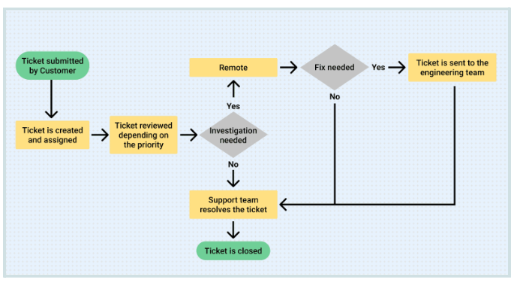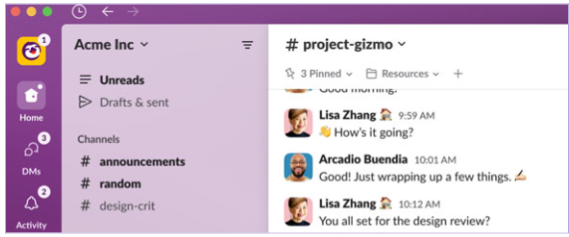Feedback loops are the ultimate form of ‘constructive feedback’ for software projects. It is the foundation of a successful software project, influencing the functionality, usability, and overall success. This is your chance, as the client, to get your voice heard and ensure that your software development project stays on track and meets all your objectives. Read on for some tips and tricks…
|
Included in this post: |
Feedback Loops - What’s it all about?
The technical definition of a feedback loop is “a process in which the outputs of a system are circled back and used as inputs”. For the rest of us, this simply refers to the process of using customer feedback to create a better product. And that’s all you want, right?
A well-crafted feedback loop is important because it allows you to quickly identify and address any issues with the development process.
Software development can be a challenging process, which is where the Agile Methodology comes in. ‘Agile’, specifically using a ‘Scrum’ framework, was specially created to meet the management needs of software development projects. One of Agile’s core values is the collaboration between the development team and you, the client. This means involving you throughout the entire software development lifecycle, not just at the beginning and the end - because your involvement really matters.
4 Opportunities for Client Feedback within a Scrum Framework
Software development is an investment for any business, especially where you want maximum return on that investment. One way to ensure that return, is to maintain constant communication between yourself and your development team - provisioning both positive and constructive feedback.
Software projects that make use of the ‘Scrum’ framework usually break their work structure down into a two week cycle, known as a ‘Sprint’. Why 2 weeks you may ask? Because it strikes a balance between productivity and flexibility - giving teams manageable workloads whilst also allowing for frequent feedback loops. If you're looking for some top communication tips - look no further :)
There are 4 main touchpoints for you within this 10 working-day framework:
-
Backlog Refinement (Day 1)
This is a planning session designed to create and confirm the requirements for your project.
This is your opportunity to explain to the development team exactly what you need and expect at the end of the project. You will be able to find the best way of doing this in the ‘Tools’ section later in the post. I’ve seen many projects fail or go over budget, because they lacked a well defined backlog. Maintaining a well defined backlog is arguably the most important part of managing a software project. -
Sprint Planning (Day 2)
This session is where you give feedback on the priority in which you would like to see the tasks completed.
For example, you can ask the development team to focus on a specific part of the project first. This could be useful if you would like to show stakeholders specific progress. -
Sprint Review (Day 9) [Spoiler: This one is important]
Attendance: Essential. Your development team will use this session to demonstrate their progress. This is your opportunity to provide critical feedback.
Work will either continue and/or change based on your feedback. Attending this session maximises the success of your project and ensures that no development time is wasted. -
Sprint Retrospective (Day 10)
The Sprint Retrospective is probably the most difficult one for clients to understand the value of attending. However, it is in this short session that you are able to provide the team with valuable feedback on the overall process, and give suggestions on improvements that you would like to see in the next sprint.
Your feedback will guide the team on how well they have done or how many improvements they need to look at making. I would definitely recommend joining the retro sessions.
4 Benefits of a Great Feedback Loop
-
Immediate improvement
Attending iterative Sprint Review meetings, where progress is demonstrated, allows for immediate improvement.
If feedback is only provided at the end of the project, a lot of unnecessary effort, time and money may have been wasted. -
Allows for evolving requirements
Your needs may evolve throughout the project, and if you are able to give frequent updates, the developers can take these changes into account much sooner. -
Meeting objectives
Great communication between you and the development team during Backlog Refinement is the only way to ensure that all your expectations and goals are met. -
Saves time and money
Early feedback allows developers to avoid major changes and or issues. This way you can save time and more importantly developmental costs.
Tools and Strategies for Effective Client Feedback
Creating a diagram
Drawing it out, creating a flowchart or otherwise providing a picture of your vision/workflow/wireframe is an extremely useful tool to help the development team understand your requirements. It will help avoid a possible misunderstanding of the requirement and is a great starting point when kicking off a project. Miro is a great free tool that you can use.
See example below:
A Minimum Viable Product (MVP)
An MVP refers to the simplest version of a product that can be released to the market. An MVP has just enough features to satisfy early adopters and provide feedback for future product development. This is something I have found to be extremely helpful and helps clients to avoid spending unnecessary time and resources on developing features that end-users do not need or want.
It can provide cost savings, fast business launches, and even getting early investor buy-in. The insights you’ll learn early on, will help you and the development team build the dream product. For more insights into the value of an MVP, please see this definition article by the Agile Alliance
Make use of chat platforms
Using chat platforms, such as Discord or Slack, is a great way to create faster feedback opportunities, rather than waiting for scheduled meetings.
This will make it easier for you and the development team to keep in contact and resolve issues in real time.
User Acceptance Testing (UAT)
UAT is another useful process that allows for more specific feedback. This is where you are able to interact with the product on a test platform, to ensure that all requirements you provided to the development team have been met.
This can be done at the end of a project, but it is more valuable if there are a number of UAT iterations. Our article about the ‘what’s and why’s’ of QAT and UAT is very helpful to understand its importance.
Overcoming Feedback Loop Challenges
There are of course challenges when it comes to facilitating successful feedback loops. Here are my 4 top tips to overcoming these challenges.
Request a Proof of Concept
One of the most common problems can be a misunderstanding of requirements. Using a phased approach to providing requirements at the start of a project, will assist with this problem.
Requesting wireframes or a simple Proof of Concept (POC) from the development team is a great way to confirm that they have understood the requirements, without having to spend development time and money.
Avoid Scope Creep
One of the biggest drawbacks when it comes to iterative development and feedback loops, is the dreaded scope creep.
To avoid scope creep that will impact cost and timelines, it is important to classify new requirements during sprint reviews as added scope that can be done at the end of the project as an additional phase/s. This will ensure that your original timeline is not impacted.
Nominate a Product Owner
Another major challenge is often that you do not have the dedicated time to give to the development team. Nominating a Product Owner to manage a software development project is one of the most important and effective ways you can ensure the requirements are correct and the product delivered meets all of your needs.
Product Owners will have the ability to attend all the Scrum ceremonies during a two week sprint period and provide the necessary feedback to the development team. They will even be able to attend the daily scrum meetings, which will allow for daily feedback between you and the software development team. I cannot recommend hiring a PO enough!
Keep your feedback loops short
Long feedback loops will lead to misaligned expectations between you and the team, as feedback may be outdated. Long feedback loops will also lead to longer development cycles. And longer development cycles will lead to higher costs, so it is important to make sure that feedback loops are as short as possible.
Conclusion
The feedback loop makes for an essential software development component that one can’t simply ignore. It adds refinement to ideas so that the end product turns out exactly how you envision it.
And finally it is important to remember that feedback loops are not a one-time activity, but a continuous cycle of learning and improvement. You should repeat the feedback loop process for each feature or requirement, and for each stage of the software development lifecycle. If you're about to embark on a new software project, you'll need strong software project management, effective communication, good feedback loops, testing, technical understanding and customer involvement for a successful outcome. Let me talk you through each of these for this ‘ultimate software project management guide’.








Comment